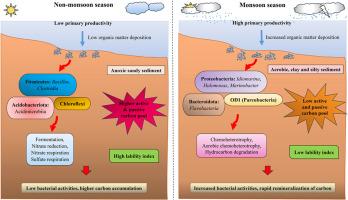Seasonal shifts in microbial communities drive differential carbon accumulation and remineralization in the eastern Arabian Sea
IF 2.6
3区 地球科学
Q1 MARINE & FRESHWATER BIOLOGY
引用次数: 0
Abstract
Marine sediments are crucial to the carbon cycle, yet the balance between carbon burial and microbial remineralization remains unclear, particularly in regions experiencing seasonal variations. In the eastern Arabian Sea (EAS), monsoon-driven seasonal changes significantly influence the primary productivity and the associated microbial activities. This study investigated the bacterial community composition and its functions in coastal and offshore sediments along the EAS during the non-monsoon and monsoon seasons, using metabarcoding analysis to understand their role in sediment carbon dynamics. The results indicate distinct seasonal shifts in bacterial communities and predictive metabolic pathways. A significant difference in carbon dynamics was detected between coastal and offshore stations (p < 0.05), with slightly higher carbon values recorded during the non-monsoon season. During the non-monsoon season, the anaerobic bacterial taxa affiliated with the phylum Firmicutes, including Bacillus, Clostridiales and Planctomycetes class Pirellulaceae, were predominant, particularly in offshore stations, which were predicted to contribute to carbon retention through fermentation and nitrate reduction pathways. In contrast, during the monsoon season, aerobic genera from the Proteobacteria, such as Idiomarina, Halomonas, Marinobacter and Salegentibacter, were dominant and associated with functions including chemoheterotrophy, aerobic chemoheterotrophy and aromatic compound degradation, indicating enhanced microbial carbon processing that likely limited sedimentary carbon accumulation despite elevated primary productivity. This study emphasizes the dynamic nature of microbial communities in regulating carbon processing in response to seasonal environmental changes. The findings have significant implications for understanding the impact of seasonal changes on carbon storage and remineralization, particularly in coastal upwelling ecosystems.

微生物群落的季节性变化驱动了阿拉伯海东部不同的碳积累和再矿化
海洋沉积物对碳循环至关重要,但碳埋藏和微生物再矿化之间的平衡仍不清楚,特别是在经历季节性变化的地区。在阿拉伯海东部,季风驱动的季节变化显著影响初级生产力和相关的微生物活动。本文研究了非季风季节和季风季节东亚沿海和近海沉积物中细菌群落的组成及其功能,并利用元条形码分析方法了解其在沉积物碳动态中的作用。结果表明,细菌群落和预测代谢途径存在明显的季节性变化。在沿海站和近海站之间发现了显著的碳动态差异(p <;0.05),而非季风季节录得的碳值则略高。在非季风季节,厚壁菌门的厌氧细菌类群占主导地位,包括芽孢杆菌、Clostridiales和Pirellulaceae植物菌纲,预计它们通过发酵和硝酸盐还原途径有助于碳潴留。相比之下,在雨季,来自变形菌门的好氧属,如Idiomarina、Halomonas、Marinobacter和Salegentibacter,占主导地位,并与化学异养、有氧化学异养和芳香族化合物降解等功能相关,表明微生物碳处理的增强可能限制了沉积碳的积累,尽管初级生产力提高了。本研究强调了微生物群落在调节碳加工过程中响应季节环境变化的动态性质。这些发现对于理解季节变化对碳储存和再矿化的影响具有重要意义,特别是在沿海上升流生态系统中。
本文章由计算机程序翻译,如有差异,请以英文原文为准。
求助全文
约1分钟内获得全文
求助全文
来源期刊
CiteScore
5.60
自引率
7.10%
发文量
374
审稿时长
9 months
期刊介绍:
Estuarine, Coastal and Shelf Science is an international multidisciplinary journal devoted to the analysis of saline water phenomena ranging from the outer edge of the continental shelf to the upper limits of the tidal zone. The journal provides a unique forum, unifying the multidisciplinary approaches to the study of the oceanography of estuaries, coastal zones, and continental shelf seas. It features original research papers, review papers and short communications treating such disciplines as zoology, botany, geology, sedimentology, physical oceanography.

 求助内容:
求助内容: 应助结果提醒方式:
应助结果提醒方式:


